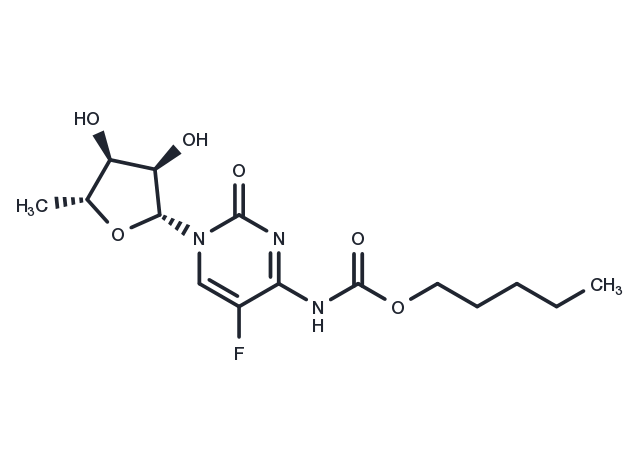Powder: -20°C for 3 years | In solvent: -80°C for 1 year
Capecitabine (Capecitibine) is a fluoropyrimidine carbamate belonging to the class of antineoplastic agents called antimetabolites. As a prodrug, capecitabine is selectively activated by tumor cells to its cytotoxic moiety, 5-fluorouracil (5-FU); subsequently, 5-FU is metabolized to two active metabolites, 5-fluoro-2-deoxyuridine monophosphate (FdUMP) and 5-fluorouridine triphosphate (FUTP) by both tumor cells and normal cells. FdUMP inhibits DNA synthesis and cell division by reducing normal thymidine production, while FUTP inhibits RNA and protein synthesis by competing with uridine triphosphate for incorporation into the RNA strand.

| パッケージサイズ | 在庫状況 | 単価(税別) | |||
|---|---|---|---|---|---|
| サンプルについてお問い合わせ | |||||
| 500 mg | 在庫あり | ¥ 10,500 | |||
| 1 g | 在庫あり | ¥ 14,500 | |||
| 5 g | 在庫あり | ¥ 37,500 | |||
| 1 mL * 10 mM (in DMSO) | 在庫あり | ¥ 11,000 | |||
| 説明 | Capecitabine (Capecitibine) is a fluoropyrimidine carbamate belonging to the class of antineoplastic agents called antimetabolites. As a prodrug, capecitabine is selectively activated by tumor cells to its cytotoxic moiety, 5-fluorouracil (5-FU); subsequently, 5-FU is metabolized to two active metabolites, 5-fluoro-2-deoxyuridine monophosphate (FdUMP) and 5-fluorouridine triphosphate (FUTP) by both tumor cells and normal cells. FdUMP inhibits DNA synthesis and cell division by reducing normal thymidine production, while FUTP inhibits RNA and protein synthesis by competing with uridine triphosphate for incorporation into the RNA strand. |
| In vitro | When administered to mice with a high propensity for liver metastasis, Capecitabine exhibits inhibitory effects on both the growth and metastatic recurrence of human hepatocellular carcinoma. This phenomenon is attributed to the high expression of platelet-driven endothelial growth factor within the tumors. Compared to 5-FU, UFT, and the intermediate metabolite 5'-DFUR, Capecitabine demonstrates a broader spectrum of anticancer activity against human transplant tumors, which is associated with the tumor levels of dThdPase. |
| In vivo | Capecitabine induces apoptosis in a Fas-dependent manner and exhibits toxicity sevenfold higher towards LS174T-c2 cells, which are transfected with thymidine phosphorylase, leading to more pronounced apoptosis. When cultured in the same plate as HepG2 cells, both LS174TWT and LS174T-c2 cells show increased sensitivity to Capecitabine, with IC50 values decreasing from 890 μM when LS174TWT cells are cultured alone to 630 μM when co-cultured with HepG2 cells. Additionally, for the LS174T-C2 subtype co-cultured with HepG2 cells, the IC50 significantly drops from 330±4 μM to 89±6 μM. |
| 細胞研究 | HepG2 and either LS174T WT or LS174T-c2 cells are seeded, respectively, in the top and bottom chambers of 8-well strip membranes in 96-well plates. The exponentially growing cells are exposed to increasing concentrations of capecitabine. The medium is supplemented with 750 ng/mL ZB4 MoAB or 100 ng/mL BR17 MoAB when the latter are used in the experiments. After 72 hours of continuous exposure, LS174T viability is assessed using the classic colorimetric MTT test.(Only for Reference) |
| 別名 | Xeloda, Capecitibine, Capiibine, RO 09-1978 |
| 分子量 | 359.35 |
| 分子式 | C15H22FN3O6 |
| CAS No. | 154361-50-9 |
Powder: -20°C for 3 years | In solvent: -80°C for 1 year
5% DMSO+95% Saline: 1.8 mg/mL (5 mM)
Ethanol: 35.9 mg/mL (100 mM)
DMSO: 35.9 mg/mL (100 mM)
You can also refer to dose conversion for different animals. 詳細
bottom
Please see Inhibitor Handling Instructions for more frequently ask questions. Topics include: how to prepare stock solutions, how to store products, and cautions on cell-based assays & animal experiments, etc.
Capecitabine 154361-50-9 Apoptosis Cell Cycle/Checkpoint DNA Damage/DNA Repair DNA/RNA Synthesis Nucleoside Antimetabolite/Analog Xeloda inhibit Capecitibine Inhibitor Capiibine RO 09-1978 inhibitor
